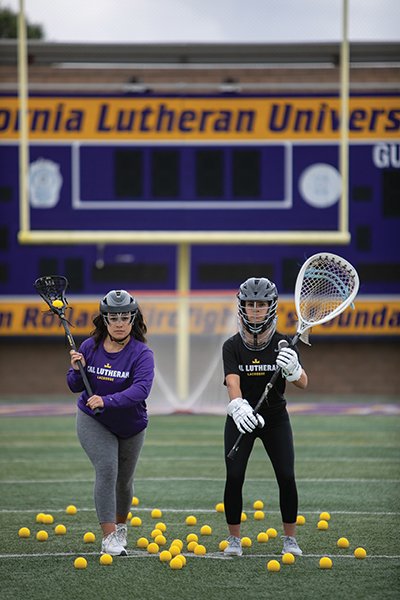Lacrosse goals
Swept up in the sport’s rapid West Coast expansion, the university assembles a Regals squad for spring 2020.

Active participants in the sport’s growth, sisters Sarah (left) and Cameron Mendez pushed to start lacrosse teams at their high school and now Cal Lutheran.
Photo: Brian StethemWhen Cameron and Sarah Mendez, now going into their junior year, get to talking about lacrosse, they finish each other’s sentences like two players passing a ball. The 20-year-old twins don’t waste time. After beginning club lacrosse in seventh grade, they joined with other students and parents to lobby their Conejo Valley private school for a high school varsity team and then played on it for four years.
Sarah became a midfielder and attacker. When their club team goalkeeper went off to high school, Cameron answered a call to train for that position.
“Ever since I said, ‘I’ll try it,’” Cameron began – “She’s been stuck with it ever since,” said Sarah – “and I wouldn’t like it any other way,” continued Cameron. “I love it, the pressure.”
The Mendez sisters intended to play college lacrosse, possibly in different states, before both decided on Cal Lutheran for academic and financial motives. Promptly, they commenced a new campaign for a team and found a receptive audience in administrators and a Board of Regents seeking to balance football with an 11th women’s NCAA sport.
In January, head coach Laura McIntyre arrived to begin building toward an inaugural spring 2020 season and beyond.
The seventh team in the Southern California Intercollegiate Athletic Conference (SCIAC), which added women’s lacrosse a decade ago, the Regals are part of a suddenly sizable West Coast tradition.
Invented by Native Americans, lacrosse grew up on the East Coast and summers in Canada. With rare exceptions, NCAA titles go to teams in the Northeast and mid-Atlantic. But competition is rising in the West, Midwest, Southeast and pockets of Texas, according to McIntyre, who watched lacrosse grow for five years as an assistant coach at The University of the South in Sewanee, Tennessee.
In California, 8,880 girls played for 257 high schools in 2017-18, compared with 1,834 players and 55 schools just 15 years prior, according to the National Federation of State High School Associations, which tracks student activities. That puts populous California at No. 3 in varsity girls’ participation, after New York and New Jersey and ahead of Massachusetts and Pennsylvania.
Recent rule changes have sped up Division III play, adding to the excitement, McIntyre said. A 90-second shot clock and self-starts after fouls, similar to soccer and field hockey, ensure a more fluid game. The continuous movement requires endurance from players and suits McIntyre’s coaching style.
“I’m very much a coach that wants to have that spread offense,” she said. “I really want to utilize every player and their strengths as opposed to having one player who we rely on for everything.”
McIntyre was a goalkeeper, one of three seniors, and “the mom” on Gettysburg College’s first-ever Division III national championship team in 2011. Next, while completing a master’s in counseling, she served as a graduate assistant coach for three years at McDaniel College in Maryland.
“I’ve had some amazing female mentors, and ever since I was little, I always knew I wanted to be like them,” she said. “I knew I wanted to have that same impact on someone else in the future.”
She and her older sister had started lacrosse in Pennsylvania because T-ball didn’t give them enough action. Back in Wisconsin, their parents had never witnessed “the fastest game on two feet,” as lacrosse boosters style the sport. “I don’t think my dad ever realized that it would become my career,” she said.
Now that she’s charged with launching a program, McIntyre’s objective is to assemble about 18 women for the spring season, with a maximum roster of 28 or 30 over time. She has a day of nonconference competition scheduled for Oct. 19.
Recruits will likely come both from afar and from the fast-growing high school scene. Girls’ lacrosse spread to nearly every Conejo Valley school while Steve Omlor ’09, a former Kingsmen pitcher, was helping to build the program at Agoura Hills. He departed as head coach in 2018.
Throwing and catching, the basis of lacrosse, take practice but can be mastered by soccer and basketball players who’ve never lifted a stick. High school and Division III teams poach athletes from field hockey and track, and bring on first-timers.
“Explaining the movement of the game is a lot easier to someone who understands basketball – how to set a pick, how to set a screen, how to roll off of a screen, how to do a zone defense, how to slide for help, all those little things,” said Omlor.
The Mendez twins don’t want anyone to be afraid to try out their sport. “I mean, it’s fun to pick up and once you’re at it—” said Sarah. “Once you get it, it’s just an instinct at that point,” put in Cameron. Concluded Sarah: “It’s addicting.”